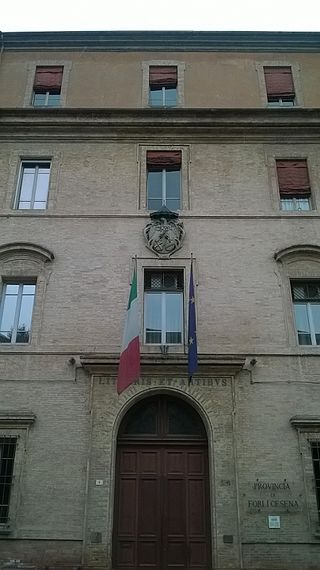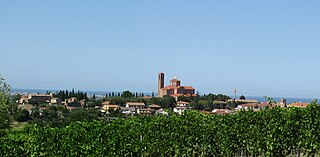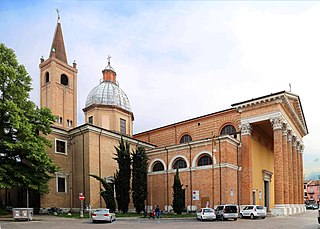
Romagna is an Italian historical region that approximately corresponds to the south-eastern portion of present-day Emilia-Romagna, North Italy. Traditionally, it is limited by the Apennines to the south-west, the Adriatic to the east, and the rivers Reno and Sillaro to the north and west. The region's major cities include Cesena, Faenza, Forlì, Imola, Ravenna, Rimini and City of San Marino. The region has been recently formally expanded with the transfer from the Marche region of nine comuni where the Romagnol language is spoken.

The House of Riario, sometimes referred to as Riario-Sforza, is an Italian noble family from Savona, near Genoa. Closely associated with the Papal States, the family gained control over several signorie ("lordships"), such as Bologna and Forlì.

The province of Forlì-Cesena is a province in the Emilia-Romagna region of Italy. Its capital is the city of Forlì. The province has a population of 394,273 as of 2016 over an area of 2,378.4 square kilometres (918.3 sq mi). It contains 30 comuni and the provincial president is Davide Drei. Although located close to the independent Republic of San Marino, Forlì-Cesena does not share a land border with the sovereign state.

The province of Ravenna is a province in the Emilia-Romagna region of Italy. Its capital is the city of Ravenna. As of 2015, it has a population of 391,997 inhabitants over an area of 1,859.44 square kilometres (717.93 sq mi), giving it a population density of 210.81 inhabitants per square kilometre. Its provincial president is Claudio Casadio.

Forlimpopoli is a town and comune in the province of Forlì-Cesena, north-eastern Italy. It is located on the Via Emilia between Cesena and Forlì.

Forlì is a comune (municipality) and city in Emilia-Romagna, Northern Italy, and is the capital of the province of Forlì-Cesena. It is the central city of Romagna.

Coriano is a comune in the province of Rimini. This town is known for being the city of the Motorcycle World Champion, in 250cc class, Marco Simoncelli.

Barbara Manfredi (1444–1466) was the wife of Pino III Ordelaffi, lord of Forlì (Italy).
Maghinardo Paganiof Susinana was an Italian condottiero and statesman living in the 13th-14th centuries. He was seignior of Faenza and Imola, and attempted unsuccessfully to conquer also Forlì.
Pino IOrdelaffi was an Italian condottiero and lord of Forlì from 1386 until his death. A member of the Ordelaffi family, he was the son of Giovanni Ordelaffi and Tebalda Malatesta. He was also Papal vicar of Forlimpopoli, Castrocaro Terme and Sarsina.

Pino III Ordelaffi was an Italian condottiero and lord of Forlì. He was a member of the Ordelaffi family.
Sinibaldo II Ordelaffi was the lord of Forlì in 1480, inheriting it from his father Pino III Ordelaffi. After his death the Ordelaffi lost the control of the city, who was acquired by Pope Sixtus IV's nephew Girolamo Riario. Sinibaldo's relative Francesco V Ordelaffi shortly claimed the lordship, but in vain.
Francesco II Ordelaffi, also known as Cecco II, was a lord of Forlì, the son of Sinibaldo Ordelaffi and Orestina Calboli, and the grandson of Teobaldo I Ordelaffi.
Giovanni Manfredi (1324–1373) was lord of Faenza from 1341 until 13 September 1356, as well as of numerous other minor fiefs in Romagna.

The Diocese of Forlì-Bertinoro is a Latin diocese of the Catholic Church in Romagna, Italy. Until 1986 it was known as the Diocese of Forlì, in existence perhaps from the fourth century. In that year the Diocese of Bertinoro was united to it. The diocese is suffragan to the Archdiocese of Ravenna-Cervia.
The Catholic diocese of Sarsina was a Roman Catholic ecclesiastical territory in Emilia-Romagna, northern Italy, seated in Sarsina, in the province of Forlì, some 32 km south-southwest of Cesena. The diocese was founded in the 5th century, and was suffragan (subordinate) to the archbishop of Ravenna. The diocese existed until 1986, when it was united with the diocese of Cesena.
Forum Popilii is a Catholic titular see. The current Titular Bishop of Forum Popilii is Robert Joseph Fisher.
The Italian Catholic diocese of Bertinoro existed from 1360 to 1986. In that year it was merged with the diocese of Forlì to create the diocese of Forlì-Bertinoro.
Galeotto I Malatesta (1299–1385) was an Italian condottiero, who was lord of Rimini, Fano, Ascoli Piceno, Cesena and Fossombrone.
This article presents a detailed timeline of the history of the Republic of Venice from its legendary foundation to its collapse under the efforts of Napoleon.











